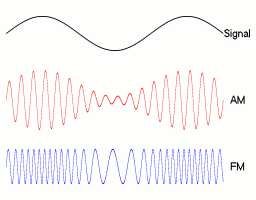(Important Topics) Physics: Modulation - Communication System
Disclaimer: This website is NOT associated with CBSE, for official website of CBSE visit - www.cbse.gov.in

Important Topics Physics: Modulation - Communication System
Modulation
Modulation is an important step of communication system. Modulation is defined
as the process whereby some characteristic (line amplitude, frequency, phase of
a high frequency signal wave (carrier wave) is varied in accordance with
instantaneous value intensity of low frequency signal wave (modulating wave.)
Need for modulation : -
(i) To separate signal from different transmitters :-
Audio frequencies are within the range of 20 Hz to 20 kHz. Without modulation
all signals at same frequencies from different transmitters would be mixed up.
There by giving impossible situation to tune to any one of them. In order to
separate the various signals, radio stations must broadcast at different
frequencies.
Each radio station must be given its own frequency band. This is achieved by
frequency translation as a result of modulation process.
(ii) Size of the antenna : –
For efficient transmission the transmitting antennas should have length at least
equal to a quarter of the wavelength of the signal to be transmitted. For an
electromagnetic wave of frequency 15 kHz, the wavelength λ is 20 km and
one-quarter of this will be equal to 5 km. Obviously, a vertical antenna of this
size is impractible. On the other hand, for a frequency of 1 MHz, this height is
reduced to 75m.
Also, the power radiated by an antenna of length l is proportional to (l/λ)2. This shows that for the same antenna length, power radiated is large for shorter wavelength. Thus, our signal which is of low frequency must be translated to the high frequency spectrum of the electromagnetic wave. This is achieved by the process of modulation.
Types of modulation :-
A sinusoidal carrier wave can be expressed as
ec = Ec cos(ωc t + θ)
Its three distinct characteristics are:
(i) Amplitude (Ec)
(ii) angular frequency (ωc)
(iii) phase angle (θ).
Either of these three characteristics can be varied in accordance with the
modulating signal. These result in three types of modulation.
(i) Amplitude modulation (AM)
(ii) Frequency modulation (FM)
(iii) Phase modulation (PM)